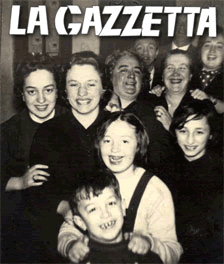Cultural Diversity

- SUBSCRIBE
- ALREADY SUBSCRIBED?
BECOME A BONJOUR PARIS MEMBER
Gain full access to our collection of over 5,000 articles and bring the City of Light into your life. Just 60 USD per year.
Find out why you should become a member here.
Sign in
Fill in your credentials below.
 A few days ago I was sitting minding my own business and eating some mighty-fine oysters in the Grand Central Oyster Bar (yes, I’m not always in Paris although it might appear that way – I occasionally venture out to exotic places like Binghampton, NY, Spoletto, Baltimore, the Peloponese, Issy-les-Moulineaux, Venice (actually 50-50 Venice/Mestre,) etc.) I noticed two big tables fill up with 24 bright-looking, eager young people wearing name tags.
A few days ago I was sitting minding my own business and eating some mighty-fine oysters in the Grand Central Oyster Bar (yes, I’m not always in Paris although it might appear that way – I occasionally venture out to exotic places like Binghampton, NY, Spoletto, Baltimore, the Peloponese, Issy-les-Moulineaux, Venice (actually 50-50 Venice/Mestre,) etc.) I noticed two big tables fill up with 24 bright-looking, eager young people wearing name tags.
And, as I watched them, I realized that they were so different from what you’d see in Paris. Sure there were some clear Anglo-Saxon genes in the pool, but among them were Asian, African, African-American, Latino, Muslim, orthodox Jewish, Slavic, Scots or Irish (the hair’s a giveaway), Nordic (ditto), who knows, Zoroastrian, (for all I could tell) folks. In France, in a similar place, it would be 100% Franco-Francais. Why the difference?
A recent New York Times article* noted that in 2005, 12.8 million immigrants became naturalized United States citizens and that an increasing number of immigrants hale from Asia and Latin America and fewer are European. Meanwhile in France, while there is one second-generation immigrant – Nicolas Sarkozy – running for the highest position in the country, one is not struck by diversity among ordinary folk, e.g., eating companions.
As the kids would say, get to the point Dad! How does this relate to food?
While fusion cuisine, in France or the US, is an old concept, French food critics are increasingly critical of the insularity of French chefs’ menus, the inability of the Michelin inspectors to evaluate other-than-French-cuisine and the incuriousness of the French for what’s going on in Las Roses, Berkeley or Hong Kong. Omnivore and Le Fooding are pumping for more diversity but except for the silly pairings of the 70’s (kiwis and ketchup, etc) and use of “exotic” spices and ingredients such as seaweed, piment d’Espelette and raw fish, the most adventuresome additions recently have been crumble, risotto and noodles.
Can it be that the food served in Paris reflects the populace’s ethnic diversity or lack thereof and the cultural diversity among the diners rubs off on the kitchen staffs? Not really, because in most American restaurants, as Tony Bourdain famously noted, the staff best equipped to carry out classical French dishes were Latin Americans, not French. On the other hand, if larger, even smaller cities have sizeable Chinatowns, Japantowns, Greektowns, etc., some of their ethnic food ingredients and preparations must rub off onto other restaurateurs.
One also wonders what the effect is of chefs from other nations on cooking in France. Not just the Japanese of years gone by who brought in Japanese/French fusion cooking to Cartes Postales and Stella Maris but the Yank Daniel Rose at Spring, the Swedish chef Petre Nilsson at the Italianate La Gazzetta or the interesting Irish duo – Carolyn Buckley in the kitchen at Le Bistrot des Faubourgs serving carrot and ginger soup and crumble and Audrey Concannon, who minds the front room at Urbane, but who must have an influence on her husband’s use of horseradish sauce, curry and lollipops.
If Le Fooding, Gilles Choukroun (who was much more diverse at the Café des Delices than Angl’Opera) and company have their way, it should be an interesting and diversifying next few years.
*Immigrants Becoming U.S. Citizens at High Rate. Julia Preston. New York Times. Thursday March 29, 2007, p. A12
My favorites from among the above:
Spring
28, rue de la Tour d’Auvergne, 9th, (Metro: St Georges or Pigalle)
T: 01.45.96.05.72
Open for dinner everyday but Sunday and Sunday (now and about to open for lunch Thursday and Friday)
Menu du jour 36 €
La Gazzetta
29, rue de Cotte, 12th, (Metro: Ledru Rollin)
T: 01.43.47.47.05
Closed Sunday night and Mondays
Lunch menu 14 €, a la carte 30-60 €
©2007 John A. Talbott


